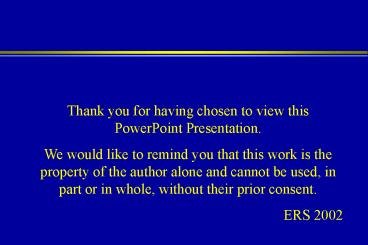ISAAC Global rhinitis data - PowerPoint PPT Presentation
1 / 17
Title:
ISAAC Global rhinitis data
Description:
We would like to remind you that this work is the property of the author alone ... 'Antidote to determinism' Genetic susceptibility, perinatal programming ... – PowerPoint PPT presentation
Number of Views:46
Avg rating:3.0/5.0
Title: ISAAC Global rhinitis data
1
- Thank you for having chosen to view this
PowerPoint Presentation. - We would like to remind you that this work is the
property of the author alone and cannot be used,
in part or in whole, without their prior consent. - ERS 2002
2
Slides for David Strachan
- ERS Workshop on Post-Genome Epidemiology, Cernay,
France
3
The hazards of everyday life
- Most strong associations are already discovered
- Weak associations, widely spread, may add up to a
lot of trouble, but are unconvincing for
causality
Spurious associations True weak
associations (false alarms, scares) (focus for
prevention) Play of chance Bias Imprecise
measurements Residual confounding Strong
subgroup effects
4
Why study interactions?
- Antidote to determinism
- Genetic susceptibility, perinatal programming
- Lifecourse approach to disease causation
- More certain identification of remediable causes
- Interaction relative risks larger than overall
relative risk - Bias and confounding more easily excluded
- Guidance for public health policy
- Safety for susceptibles
5
The relevance of weak associations
Incidence
- Exposure RR PARF
- A- 20 1.0 0
- A 80 1.5 29
- A small excess risk widely spread adds up to a
lot of trouble ... - ... but is difficult to distinguish from bias and
confounding
6
Effect concentration among susceptibles
Incidence
E F G H
A B
C D
Exposure RR PARF A- B- 1.0 0 A- B 1.0 0
A B- 1.0 0 A B 3.5 29
7
Pros and cons of studying interactions
- Pros
- Biologically plausible
- Improve specificity
- Increase strength in susceptible subgroups
- Less prone to bias and confounding
- Cons
- Scale dependent
- Problems of multiple comparisons
- Large samples often considered necessary for
adequate power
8
Effect concentration relative risk (1)
- B- B All Cases
- Prevalence 80 20 for A
- A- 20 1.0 1.0 1.0
- A 80 1.0 3.5 1.5 374
- All 1.0 3.0
- Cases required for B 32
- Cases required for AB 242
80 power 5 significance Large
cohort Rare disease
9
Effect concentration sample size (1)
80 power 5 significance
10
Effect concentration sample size (2)
11
Multiple subgroups of susceptibles
Incidence
Exposure RR PARF A- 1.0 0 A B- 1.0 0
A B 3.5 29 A W 3.5 7 A X 3.5 7
A Y 3.5 7 A Z 3.5 7
12
Partial identification of susceptibles (1)
Incidence
W - unmeasured X - unmeasured Y - unmeasured Z -
measured
A B
Exposure RR PARF A- Z- 1.0 0 A- Z 1.0 0
A Z- 1.4 22 A Z 3.5 7
13
Partial identification of susceptibles (2)
- Z- Z All Cases
- Prevalence 95 5 for A
- A- 20 1.0 1.0 1.0
- A 80 1.4 3.5 1.5 374
- All 1.3 3.0
- Cases required for Z 162 (RR 3.0 / 1.3 2.3)
- Cases required for AZ 1471 (RR 3.5 / 1.4
2.5)
14
Partial identification of susceptibles (3)
15
Effect concentration a summary
Incidence
- Susceptibles fully identified
- Increased RR in subgroup
- Power to detect interaction with sample sizes
required to detect main effects - Susceptibles partly identified
- Less marked increase in RR
- Loss of power to detect the effect concentration
16
Epidemiology in the 21st century
- Increased focus on effect modification, rather
than association, as the basis for causal
inference. - Success is most likely in diseases where
synergistic biological interactions are already
suspected. - Success in common multifactorial diseases is
less likely and will depend on aggregating
susceptibility. - Functional traits (if they can be measured) may
be more informative than genotypes for this
purpose.
17
Prediction is an uncertain business...
- I think there is a world market for maybe five
computers. (Chairman of IBM, 1943) - Computers in the future may weigh no more than
1.5 tons. (Popular Mechanics, 1949) - There is no reason anyone would want a computer
in their home. (Digital Corporation, 1977) - 640k should be enough for anybody. (Gates, 1981)































